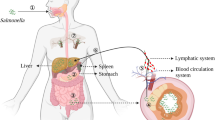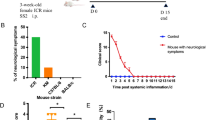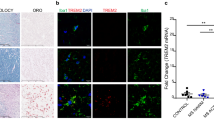Abstract
Microglial cells, the resident phagocytes in the brain, share many phenotypical and functional characteristics with peripheral macrophages, suggesting that they may participate in an innate immune response against microorganisms invading the central nervous system (CNS). In this study, we demonstrate that the microglial cells constitutively exhibit antibacterial activity in vitro against Streptococcus pneumoniae. By using a Pneumococcal surface protein C (PspC)-deleted strain and its wild-type counterpart, we found that the extent of such an activity is significantly influenced by the presence of a PspC molecule on the bacterial surface. The PspC− mutant FP20 is indeed more susceptible than the PspC+ strain HB565 to microglial killing. Interestingly, this phenomenon is observed when using a medium supplemented with heat-inactivated foetal bovine serum (FBS). Electron microscopy studies indicate that the microglial cells interact more efficiently with PspC− than with PspC+ pneumococci. Moreover, upon infection with the PspC− mutant, microglial cells produce levels of TNF-α, MIP-2, IL-10 and nitric oxide, significantly higher than those observed with PspC+ bacteria. These findings indicate that the lack of PspC significantly enhances the susceptibility of S. pneumoniae to both bactericidal activity and secretory response by the microglial cells, suggesting that this molecule may play an important role in the invasion of CNS by pneumococcus.





Similar content being viewed by others
References
Balachandran P, Brooks-Walter A, Virolainen-Julkunen A, Hollingshead SK, Briles DE (2002) Role of Pneumococcal surface protein C in nasopharingeal carriage and pneumonia and its ability to elicit protection against carriage of Streptococcus pneumoniae. Infect Immun 70:2526–2534
Blackmore TK, Fischetti VA, Sadlon TA, Ward HM, Gordon DL (1998) M protein of the group A Streptococcus binds to the seventh short consensus repeat of human complement factor H. Infect Immun 66:1427–1431
Barluzzi R, Brozzetti A, Mariucci G, Tantucci M, Neglia R, Bistoni F, Blasi E (2000) Establishment of protective immunity against cerebral cryptococcosis by means of a avirulent, non melanogenic Cryptococcus neoformans strain. J Neuroimmunol 109:75–86
Blasi E, Barluzzi R, Bocchini V, Mazzolla R, Bistoni F (1999) Immortalization of murine microglial cells by a v-raf/v-myc carrying retrovirus. J Neuroimmunol 27:229–237
Boehm U, Klamp T, Groot M, Howard JC (1997) Cellular responses to interferon-gamma. Annu Rev Immunol 15:749–795
Braun JS, Novak R, Murray PJ, Eischen CM, Susin SA, Kroemer G, Halle A, Weber JR, Tuomanen EI, Cleveland JL (2001) Apoptosis-inducing factor mediates microglial and neuronal apoptosis caused by pneumococcus. J Infect Dis 184:1300–1309
Briles DE, Hollingshead SK, Swiatlo E, Brooks-Walter A, Szalai A, Virolainen A, Mac Daniel LS, Benton KA, White P, Prellner K, Hermansson A, Aerts PC, Van Dijk H, Crain MJ (1997) PspA and PspC: their potential for use as pneumococcal vaccines. Microb Drug Resist 3:401–408
Briles DE, Yother J, McDaniel LS (1988) Role of the pneumococcal surface protein A in the virulence of Streptococcus pneumoniae. Rev Infect Dis 10: S372–374
Brooks-Walter A, Briles DE, Hollingshead SK (1999) The pspC gene of Streptococcus pneumoniae encodes a polymorphic protein, PspC, which elicits cross-reactive antibodies to PspA and provides immunity to pneumococcal bacteremia. Infect Immun 67:6533–6542
Cheng Q, Finkel D, Hostetter M (2000) Novel purification scheme and functions for a C3-binding protein from Streptococcus pneumoniae. Biochemistry 39:5450–5457
Cundell DR, Gerard NP, Gerard C, Idänpaän-Heikkilä I, Tuomanen EI (1995) Streptococcus pneumoniae anchor to activated human cells by the receptor for platelet-activating factor. Nature. 377:435–438
Cundell DR, Weiser JN, Shen J, Joung A, Tuomanen EI (1995) Relationship between colonial morphology and adherence of Streptococcus pneumoniae. Infect Immun 63:757–761
Ding A H, Nathan C F, Stuehr D J (1988) Release of reactive nitrogen intermediates and reactive oxygen intermediates from mouse peritoneal macrophages: comparison of activating cytokines and evidence for independent production. J Immunol 141:2407–2411
Fearon DT (1978) Regulation by membrane sialic acid of β1H-dependent decay-dissociation of amplification C3 convertase of the alternative complement pathway. Proc Nat Acad Sci USA 75:1971–1975
Gonzalez-Scarano F, Baltuch G (1999) Microglia as mediators of inflammatory and degenerative diseases. Annu Rev Neurosci 22:219–240
Gray BM, Converse GM III, Dillon HCJr (1980) Epidemiologic studies of Streptococcus pneumoniae in infants: acquisition, carriage, and infection during the first 24 months of life. J Infect Dis 142:923–933
Hammerschmidt S, Talay SR, Brandtzaeg P, Chhatwal GS. (1997) SpsA, a novel pneumococcal surface protein with specific binding to secretory immunoglobulin A and secretory component. Mol Microbiol 25:1113–1124
Hellwage J, Meri T, Heikkila T, Alitalo A, Panelius J, Lahdenne P, Seppala U, Meri S (2001) The complement regulator factor H binds to the surface protein OspE of Borrelia burgdorferi. J Biol Chem 276:8427–8435
Hostetter MK (1986) Serotypic variation among virulent pneumococci in deposition and degradation of covalently bound C3b. Implications for phagocytosis and antibody production. J Inf Dis 153:682–693
Iannelli F, Chiavolini D, Ricci S, Oggioni MR, Pozzi G (2004) Pneumococcal surface protein C contributes to sepsis caused by Streptococcus pneumoniae. Infect Immun 72(5):3077–3080
Idänpaän-Heikkilä I, Simon PM, Zopf D, Vullo T, Cahill P, Sokol K, Tuomanen EI (1997) Oligosaccharides interfere with the establishment and progression of experimental pneumococcal pneumonia. J Infect Dis 176:704–712
Janulczyk R, Iannelli F, Sjoholm AG, Pozzi G, Bjorck L (2000) Hic, a novel surface protein of Streptococcus pneumoniae that interferes with complement function. J Biol Chem 275(47):37257–37263
Jarva H, Janulczyk R, Hellwage J, Zipfel PF, Bjorck L, Meri S (2002) Streptococcus pneumoniae evades complement attack and opsonophagocytosis by expressing the pspC locus-encoded Hic protein that binds to short consensus repeats 8–11 of factor H. J Immunol 168:1886–1894
Johnston RB Jr (1991) Pathogenesis of pneumococcal pneumonia. Rev Infect Dis 13:S509–517
Kalin M, Ortqvist A, Almela M, Aufwerber E, Dwyer R, Henriques B, Jorup C, Julander I, Marrie TJ, Mufson MA, Riquelme R, Thalme A, Torres A, Woodhead MA (2000) Prospective study of prognostic factors in community-acquired bacteremic pneumococcal disease in 5 countries. J Infect Dis 182:840–847
Kotarsky H, Hellwage J, Johnsson E, Skerka C, Svensson HG, Lindahl G, Sjobring U, Zipfel PF (1998) Identification of a domain in human factor H and factor H-like protein-1 required for the interaction with streptococcal M proteins. J Immunol 160: 3349–3354
Luo R, Mann B, Lewis WS, Rowe A, Heath R, Stewart ML, Hamburger AE, Sivakolundu Siva, Lacy ER, Bjorkman PJ, Tuomanen E, Kriwacki RW (2005) Solution structure of choline binding protein A, the major adhesin of Streptococcus pneumoniae. EMBO J 24:34–43
Meri S, Jarva H (2000) Complement regulatory proteins. In: Encyclopedia of the Life Sciences. Nature Publishing Group, London
Meri S, Pangburn MK (1990) Discrimination between activators and non activators of the alternative pathway of complement: regulation via a sialic acid/polyanion binding site on factor H. Proc Nat Acad Sci USA 1987:3982–3986
Mitchell L, Smith SH, Braun JS, Herzog KH, Weber JR, Tuomanen EI (2004) Dual phases of apoptosis in pneumococcal meningitis. J Infect Dis 190:2039–2046
Morgan P, Gasque P (1996) Expression of complement in the brain: role in health and disease. Immunol Today 17(10):461–466
Mostov KE, Kaetzel CS (1999) Immunoglobulin transport and the polymeric immunoglobulin receptor. In: Lamm ME, Mestecky J, Lamm M, McGhee JR (eds) Mucosal immunology. Academic, New York
Mufson MA (1990) Streptococcus pneumoniae. In: Mandell GL, Douglas RG Jr, Bennett JE (eds) Principles and practice of infectious diseases. Churchill Livingstone Inc., New York, pp 1539–1550
Musher DM (1992) Infections caused by Streptococcus pneumoniae: clinical spectrum, pathogenesis, immunity and treatment. Clin Infect Dis 14:801–807
Orihuela CJ, Gao G, Francis KP, Yu J, Tuomanen EI (2004) Tissue-specific contributions of pneumococcal virulence factors to pathogenesis. J Infect Dis 190:1661–1669
Pangburn MK, Muller-Eberhard HJ (1978) Complement C3 convertase: cell surface restriction of β1H control and generation of restriction on neuraminidase-treated cells. Proc Nat Acad Sci USA 75:2416–2420
Paton JC (1998) Novel pneumococcal surface proteins: role in virulence and vaccine potential. Trends Microbiol 6:85–87
Pearce BJ, Iannelli F, Pozzi G (2002) Construction of new unencapsulated (rough) strains of Streptococcus pneumoniae. Res Microbiol 1:2–10
Raivich G, Bohatschek M, Kloss CU, Werner A, Jones LL, Kreutzberg GW (1999) Neuroglial activation repertoire in the injured brain: graded response, molecular mechanisms and cues to physiological function. Brain Res Rev 30:77–105
Ram S, Sharma AK, Simpson SD, Gulati S, McQuillen DP, Pangburn MK, Rice PA (1998) A novel sialic acid binding site on factor H mediates serum resistance of syalited Neisseria gonorrhoeae. J Exp Med 187:743–752
Ring A, Weiser JN, Tuomanen EI (1998) Pneumococcal trafficking across the Blood-Brain-Barrier: molecular analysis of a novel biridectional pathway. J Clin Invest 102:347–360
Rosenow C, Ryan P, Weiser JN, Johnson S, Fontan P, Ortqvist A, Masure HR (1997) Contribution of novel choline-binding proteins to adherence, colonization and immunogenicity of Streptococcus pneumoniae. Mol Microbiol 25:819–829
Saleppico S, Boelaert JR, Sale FO, Mazzolla R, Morucci P, Bistoni F, Blasi E (1999) Differential effects of iron load on basal and interferon-gamma plus lipopolysaccharide enhance anticryptococcal activity by the murine microglial cell line BV-2. J Neuroimmunol 93:102–107
Sande MA, Tauber MG (2001) Pneumococcal meningitis: current pathophysiological concept. In: Tomasz (ed) Streptococcus pneumoniae: molecular biology and mechanisms of disease. Mary Ann Liebert Inc., Larchmont, pp 315–320
Shinefield HR, Black S, Ray P, Chang I, Lewis N, Fireman B, Hackell J, Paradiso PR, Siber G, Kohberger R, Madore DV, Malinowski FJ, Kimura A, Lee C, Landaw I, Anguilar J, Hansen J (1999) Safety and immunogenicity of heptavalent pneumococcal CRM197 conjugate vaccine in infants and toddlers. Pediatric Infect Dis J 18:757–763
Streit WJ, Walter SA, Pennel NA (2000) Reactive microgliosis. Prog Neurobiol 57:563–581
Tuomanen EI (1996) Molecular and cellular mechanisms of pneumococcal meningitis. Ann NY Acad Sci 797:42–52
Tuomanen EI, Masure HR (1997) Molecular and cellular biology of pneumococcal infection. Microb Drug Resist 3:297–308
van Furth AM, Roord JJ, van Furth R (1996) Roles of proinflammatory and anti-inflammatory cytokines in pathophysiology of bacterial meningitis and effect of adjunctive therapy. Infect Immun 64:4883–4890
Weiser JN, Austrian R, Sreenivasan PK, Masure HR (1994) Phase variation in pneumococcal opacity: relationship between colonial morphology and nasopharygeal colonization. Infect Immun 62:2582–2589
Wourimaa T, Kayhty H (2002) Current state of pneumococcal vaccines. Scand J Immunol 56:111–129
Yother J, Briles DE. (1992) Structural properties and evolutionary relationships of PspA, a surface protein of Streptococcus pneumoniae, as revealed by sequence analysis. J Bacteriol 174:601–609
Zhang JR, Mostov KE, Lamm ME, Nanno M, Shimida S, Ohwaki M, Tuomanen EI (2000) The polymeric immunoglobulin receptor translocates pneumococci across human nasopharyngeal epithelial cells. Cell 102:827–837
Zweigner J, Jackowski S, Smith SH, van der Merwe M, Weber JR, Tuomanen EI (2004) Bacterial inhibition of phosphatidylcholine synthesis triggers apoptosis in the brain. J Exp Med 200:99–106
Acknowledgements
We wish to thank Antonio Martino for his excellent support in artwork and Susanna Ricci for her suggestions, discussion and critical reading of the manuscript. This work was supported in part by a grant from MIUR to Samuele Peppoloni (PRIN 2003).
Author information
Authors and Affiliations
Corresponding author
Rights and permissions
About this article
Cite this article
Peppoloni, S., Colombari, B., Neglia, R. et al. The lack of Pneumococcal surface protein C (PspC) increases the susceptibility of Streptococcus pneumoniae to the killing by microglia. Med Microbiol Immunol 195, 21–28 (2006). https://doi.org/10.1007/s00430-005-0243-8
Received:
Published:
Issue Date:
DOI: https://doi.org/10.1007/s00430-005-0243-8




